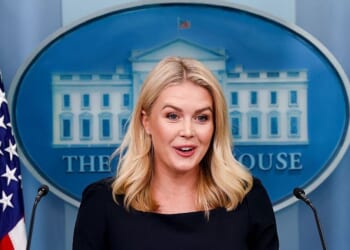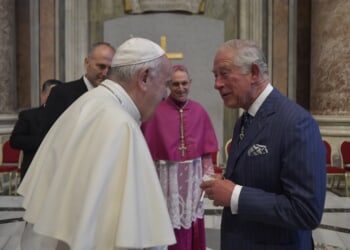In a remarkable example of how times have changed, Japan is expanding its military with NATO.
There was a time when the notion of a militarily assertive Japan would’ve sent shivers through the spines of world leaders. Indeed, the Japanese themselves, mindful of both the suffering that their nation inflicted and then suffered in return during World War II, pursued a pacifistic foreign policy throughout the Cold War and for even much of the post-Cold War era.
What a difference eight decades, and the looming threat of Chinese aggression, make. Nations that once shuddered at the thought of a stronger Japan now welcome it. This can be seen in Japan’s newly bolstered ties with the Philippines as well as multinational partnerships such as “The Quad” (among India, Australia, Japan, and the United States). And now, in a perhaps even more remarkable example of how times have changed, Japan is expanding those military ties beyond the Indo-Pacific over to NATO.
Japan and NATO
The initial inspiration for this article came from a post by Shannon Brandao, creator of the China Boss page on Substack. The post includes a witty political cartoon along with some of the following comments:
#NATO Secretary General Mark Rutte’s recent visit to Tokyo marks more than a diplomatic photo-op—it’s a clear sign that hashtag#Japan is leaving behind its postwar restraint and stepping boldly into the heart of global security … This isn’t symbolism. Japan wants in … Beijing, of course, is beside itself … Chinese officials blasted Japan for “collusion,” warning against NATO’s eastward creep … But behind the fury is fear: Japan’s pivot could normalize NATO in the Pacific—and others (Australia, South Korea, New Zealand) are already following … No, Japan’s not joining NATO – yet. But gone is the era of sitting on the sidelines.”
For additional details, we turn to an article by Mina Pollman in The Diplomat.
Rutte visited Japan on April 8-9, his first visit to that East Asian island nation under his auspices as NATO secretary general (he had previously served as prime minister of the Netherlands from October 2010 to July 2024—making him the longest-serving Dutch prime minister to date—and in that capacity, he visited Japan in 2015 and 2019).
On the first day of his trip, Rutte met with Japan’s defense minister, Gen Nakatani, and visited the Maritime Self-Defense Forces (MSDF) base at Yokosuka, whereupon he “boarded a state-of-the-art frigate” (though not identified by name, from the photo posted in a related NHK World Japan article, the frigate appears to be one of the Mogami-class) and inspected minesweeping equipment. Later that day, he visited the Mitsubishi Electric Kamakura Works.
The following day, Rutte met with Prime Minister Shigeru Ishiba; Minister of Economy, Trade and Industry Muto Yoji; members of the Diet (Japanese Parliament, that is); and representatives of Japanese industry. Rutte also gave a speech that day at Keio University in Tokyo titled “NATO and Japan – Strong Partnerships in an Interconnected World.”
Secretary-General Rutte’s Public Statements During the Visit
During that Keio speech, Rutte declared:
“Our security is clearly interlinked. What happens in the Indo-Pacific matters to Europe. What happens in Europe matters to Japan and to this region … It’s Ukraine today. It could be East Asia tomorrow.”
(That latter sentence was a repeat of an utterance by former Japanese Prime Minster Fumio Kishida.)
Meanwhile, subsequent to the meeting with Nakatani, Rutte remarked:
“China, North Korea, and Russia are stepping up their military exercises and their cooperation, undermining global stability, and that means what happens in the Euro-Atlantic matters for the Indo-Pacific and vice versa. So our security, I believe, is inseparable.”
In addition, during a press conference for his Yokosuka visit, Rutte said:
“China is supporting Russia’s efforts. China is building up its armed forces, including its navy, at a rapid pace. We cannot be naïve, and we really have to work together, assess what is happening.”
The Big Picture?
As encouraging as the notion of an expanding Japan-NATO partnership to counter China looks on paper, I can’t help but see a potential paradox at best and a conflict of interest at worst: twenty-three of the thirty-two NATO member nations are also member states of the European Union (EU)—and the EU is currently in negotiation with China to reduce tariffs on electric vehicles. In other words, these dual NATO/EU membership holders are trying to have it both ways, i.e., putting on airs of standing up to China militarily whilst concurrently expanding trade ties with Beijing.
Contrast that with the approach that the United States has taken since Donald Trump returned to the White House: continuing to bolster America’s defensive capabilities against China and standing up to China economically via heavy sanctions.
Time will tell if NATO’s and the EU’s senior leadership figure out how to reconcile that military vs. economic disconnect.
About the Author: Christian D. Orr
Christian D. Orr was previously a Senior Defense Editor for National Security Journal (NSJ) and 19FortyFive. He is a former Air Force Security Forces officer, Federal law enforcement officer, and private military contractor (with assignments worked in Iraq, the United Arab Emirates, Kosovo, Japan, Germany, and the Pentagon). Chris holds a B.A. in International Relations from the University of Southern California (USC) and an M.A. in Intelligence Studies (concentration in Terrorism Studies) from American Military University (AMU). He has also been published in The Daily Torch, The Journal of Intelligence and Cyber Security, and Simple Flying. Last but not least, he is a Companion of the Order of the Naval Order of the United States (NOUS). If you’d like to pick his brain further, you can ofttimes find him at the Old Virginia Tobacco Company (OVTC) lounge in Manassas, Virginia, partaking of fine stogies and good quality human camaraderie.
Image: DVIDS.
















